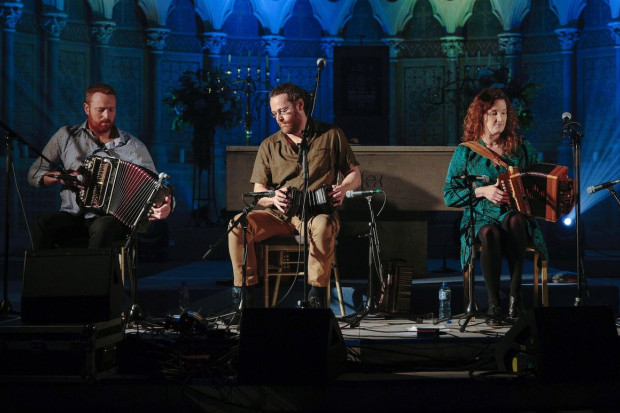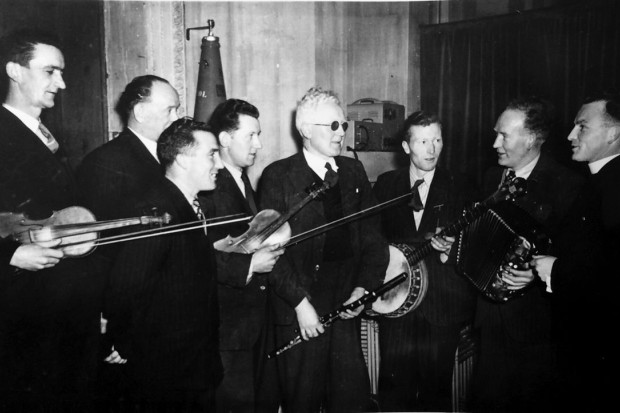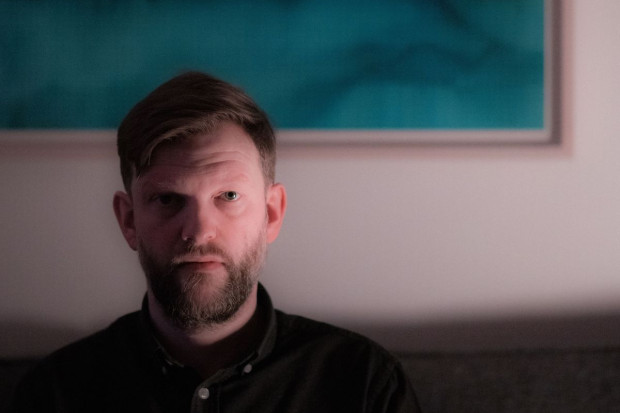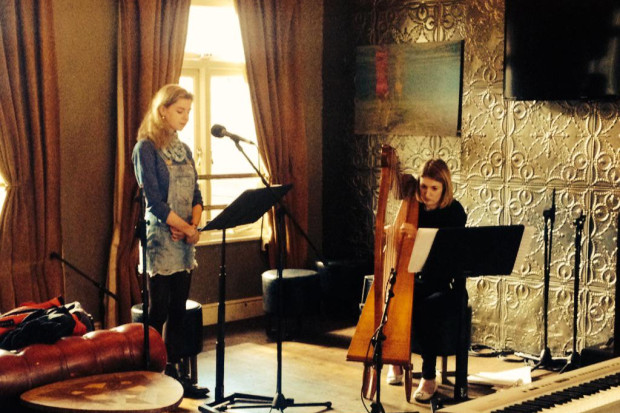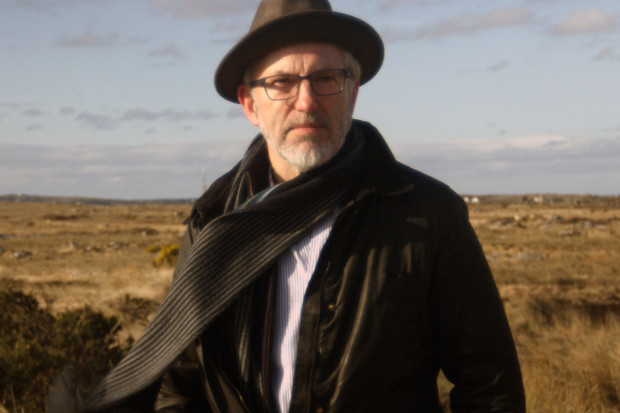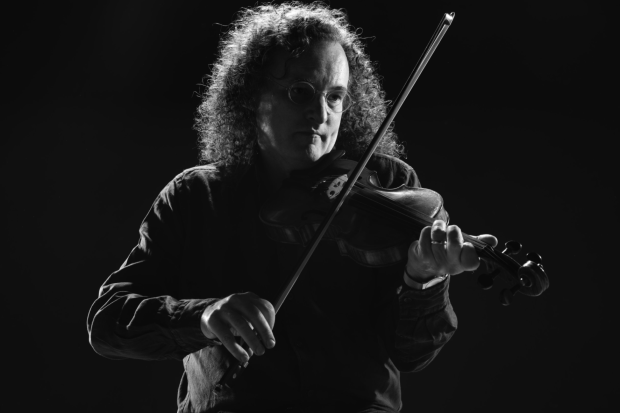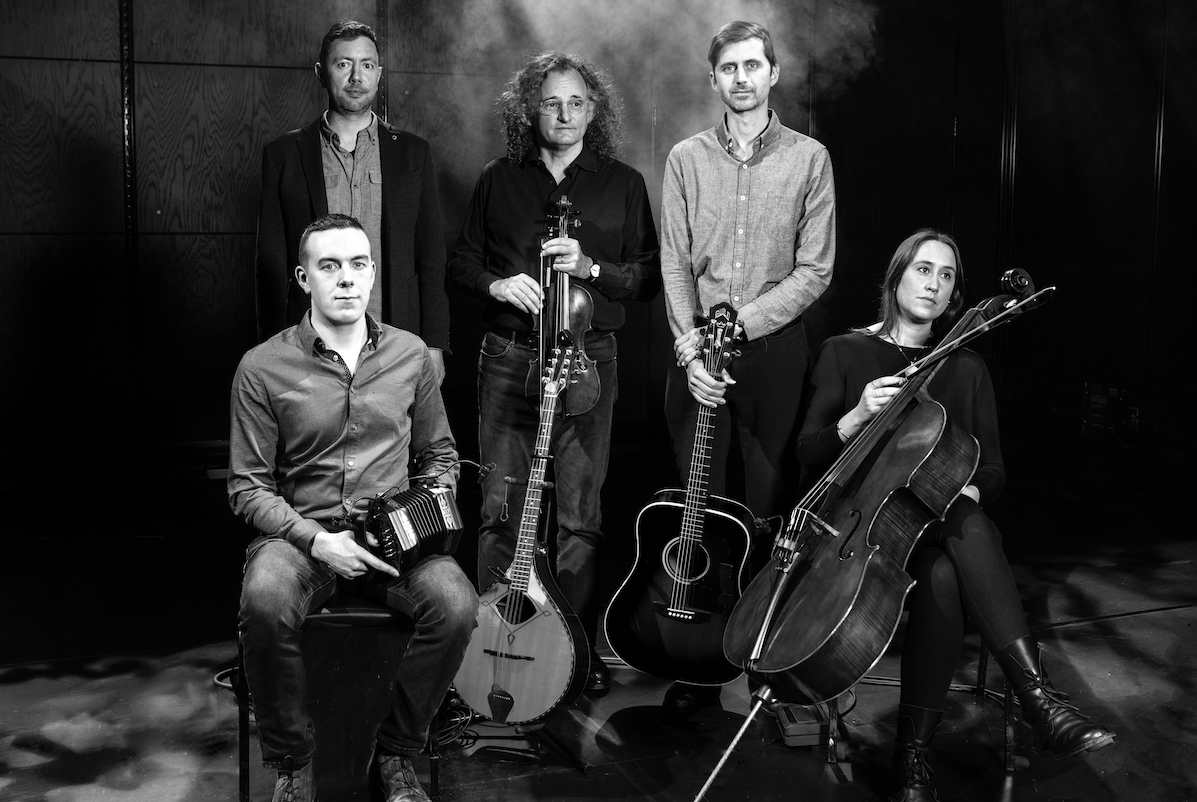
Martin Hayes and the Common Ground Ensemble (Photo: Richard Wade)
The Challenge of Moving Beyond Common Ground
Building on his ensemble work with The Gloaming and his own quartet, fiddler Martin Hayes has assembled a new group of musicians from a diverse range of genres to record a new album, Peggy’s Dream, which is dedicated to the memory of the late guitarist Dennis Cahill, the long-time musical partner of Hayes. The Common Ground Ensemble were formed with the design of, according to the press release, ensuring that ‘all of these genres are interwoven with the core elements of the tradition in a way that also gives each musician’s remarkable talents the space to shine’. Continuity with Hayes’ previous work is provided by the piano of Cormac McCarthy and Kyle Sanna’s guitar; a new addition to the soundworld of Hayes’ ensembles is Kate Ellis’ cello. While these three musicians are familiar to varying degrees with traditional music, and all operate across genre boundaries, each brings different musical languages to bear on the project. McCarthy is a composer and arranger in a contemporary jazz style; Ellis has been a director and performer with the Crash Ensemble for many years; and Sanna is a New York-based composer, arranger and improvisor. A connection with Clare music and tradition comes from the fifth member of the group, Brian Donnellan (concertina, harmonium and bouzouki), who like Hayes has been a member of the Tulla Céilí Band.
This Clare dimension is further emphasised through the inclusion of canonic tunes such as ‘Garrett Barry’s’, memorably recorded by Paddy Canny on a Gael Linn 78rpm, and ‘The Glen of Aherlow’, one of the tunes recorded by Canny and P.J. Hayes on the famous All-Ireland Champions LP. In general, the tunes chosen here will be familiar to many, and it is always of interest to hear how such evergreen tunes get refracted through the imagination of the musicians.
Both of these are standout tracks from this new CD, as they achieve a dialogue where the musicians are on an equal footing. ‘Garrett Barry’s’ gives ample space for Ellis and Sanna to create a contemporary soundworld, out of which Hayes’ fragments tentatively coalesce into the tune. A more settled texture develops, with dark drones reminiscent of Lankum’s recent work, rounded off by a coda similar to the opening. In ‘The Glen of Aherlow’ (unusually played in G minor), Hayes takes an expansive approach to varying the tune, with sparsely beautiful accompaniment on cello and guitar. A break allows the piano to come to the fore, in a somewhat filmic passage (some of the piano gestures are very similar to those used in Thomas Newman’s score to American Beauty). It’s perhaps the most substantial passage on the CD in which the tune gives way to more free-form improvisation and composition, bar a few phrases from the tune that are bounced between McCarthy and Hayes.
At the same time, these arrangements reveal some of the flaws of this album: they draw on a harmonic approach that is overused throughout, and (as on ‘Garrett Barry’s’) the ‘non-traditional’ sounds tends to be peripheralised or simply used as a backdrop to the tune. Too many tracks lapse back into the style of arrangement that was so successful for The Gloaming. Take the opening march, ‘The Boyne Water’, where McCarthy’s piano emulates the type of modal/open style of Dennis Cahill’s and Thomas Bartlett’s work, with slow-moving harmonies and a clever use of inversions. Although the two ‘breaks’ from the tune have a fuller texture, with Ellis and Donnellan adding harmonics and richer drones and the harmony moving away from the tune’s basis, when the tune returns the accompaniment almost totally adheres to a structure where chord changes happen every two bars. Similar patterns are found in sections of ‘Hughie Travers’ Reel’, ‘The Magerabaun Reel’, and ‘Cá Bhfuil an Solas’ (composed by Peadar Ó Riada); the surface details and the instrumentation might change, but the chords remain the same, so to speak.
Swing and lift
Not all tracks follow this model though: for instance, ‘The Longford Tinker’ begins with a minimalist-inspired texture, with pulsing cello and guitar riffs, over which are delicate piano fills and Hayes’ improvisations. Here the tune is adjusted to fit the arrangement: Hayes and Donnellan avoid playing the third part of the tune until the fourth round to allow another slow-moving minor-inflected chord cycle to bed in, and to really emphasise the change to the major in the third part. The build-up of the texture works, but the climactic major borders on the trite; what piques the interest instead is that directly after this the whole minimalist backdrop ceases and Hayes and Donnellan play the tune (with more swing and lift) without any backing.
Perhaps the highlight of the album is ‘Toss the Feathers’ (although the opening fits the template too), where McCarthy in particular gets to highlight his jazz chops, with Hayes cleverly using the opening of the tune as a foil for this. The odd thing is that the track rather runs out of steam – the second tune relapses back into the formula underpinning most of the album, and concludes with a progression that is surprisingly pedestrian, given the capabilities of the musicians involved.
I imagine Peggy’s Dream will appeal to lots of listeners; the musicians certainly play excellently – Hayes is flawless throughout, his playing evocative and emotional in the slower tunes, and exciting in the dance tunes – and sound like they are enjoying what they do immensely. The sound is round and sumptuous, and because of the arc of the tracks – the slow build up, the Dionysian climaxes – it will doubtlessly be tremendously effective live in concert. But the problem is that there’s rarely anything to either challenge the listener or to bring them into a new musical space. One wonders also why the instruments are so hidebound in their roles – these are all highly experienced musicians, so why do they so rarely take the lead? The Common Ground Ensemble might have been intending to explore the liminal spaces between traditions, but its approach too often retreats to the safe space of its predecessors.
Peggy’s Dream by Martin Hayes and the Common Ground Ensemble is released on 251 Records/Faction. To purchase the album on CD or vinyl, visit www.martinhayes.com/mh-store.
Subscribe to our newsletter.
Published on 6 April 2023
Adrian Scahill is a lecturer in traditional music at Maynooth University.










